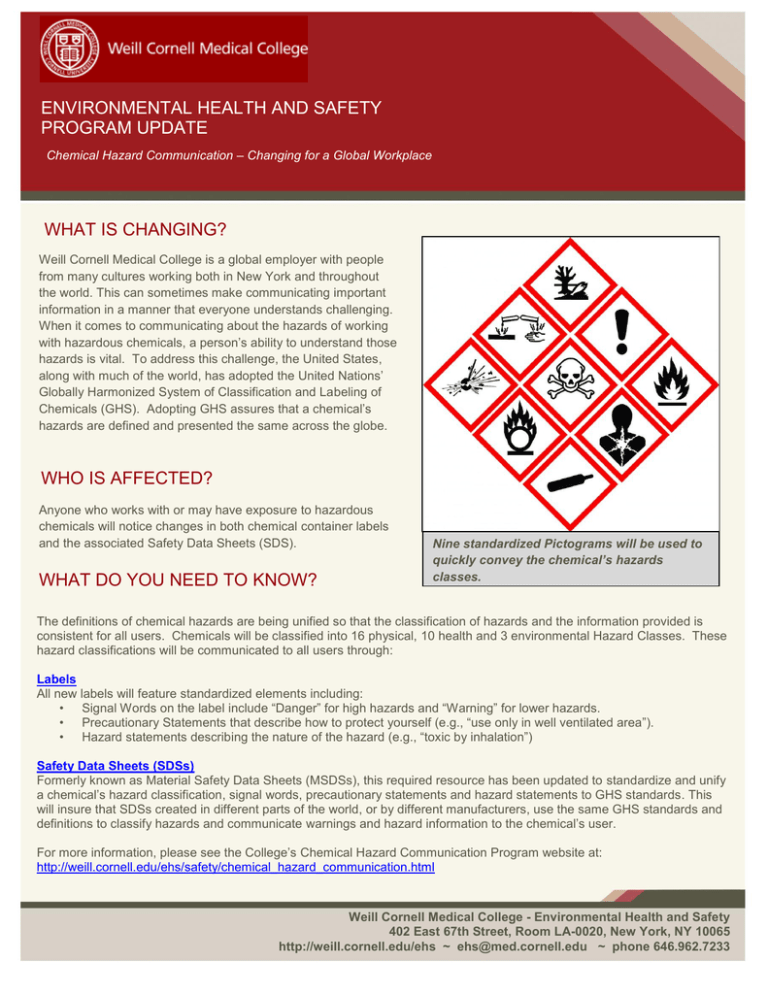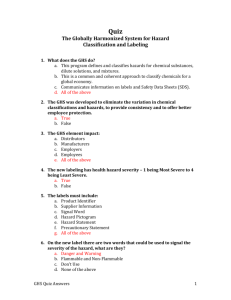WHAT IS CHANGING? ENVIRONMENTAL HEALTH AND SAFETY PROGRAM UPDATE
advertisement

ENVIRONMENTAL HEALTH AND SAFETY PROGRAM UPDATE Chemical Hazard Communication – Changing for a Global Workplace WHAT IS CHANGING? Weill Cornell Medical College is a global employer with people from many cultures working both in New York and throughout the world. This can sometimes make communicating important information in a manner that everyone understands challenging. When it comes to communicating about the hazards of working with hazardous chemicals, a person’s ability to understand those hazards is vital. To address this challenge, the United States, along with much of the world, has adopted the United Nations’ Globally Harmonized System of Classification and Labeling of Chemicals (GHS). Adopting GHS assures that a chemical’s hazards are defined and presented the same across the globe. WHO IS AFFECTED? Anyone who works with or may have exposure to hazardous chemicals will notice changes in both chemical container labels and the associated Safety Data Sheets (SDS). WHAT DO YOU NEED TO KNOW? Nine standardized Pictograms will be used to quickly convey the chemical’s hazards classes. The definitions of chemical hazards are being unified so that the classification of hazards and the information provided is consistent for all users. Chemicals will be classified into 16 physical, 10 health and 3 environmental Hazard Classes. These hazard classifications will be communicated to all users through: Labels All new labels will feature standardized elements including: • Signal Words on the label include “Danger” for high hazards and “Warning” for lower hazards. • Precautionary Statements that describe how to protect yourself (e.g., “use only in well ventilated area”). • Hazard statements describing the nature of the hazard (e.g., “toxic by inhalation”) Safety Data Sheets (SDSs) Formerly known as Material Safety Data Sheets (MSDSs), this required resource has been updated to standardize and unify a chemical’s hazard classification, signal words, precautionary statements and hazard statements to GHS standards. This will insure that SDSs created in different parts of the world, or by different manufacturers, use the same GHS standards and definitions to classify hazards and communicate warnings and hazard information to the chemical’s user. For more information, please see the College’s Chemical Hazard Communication Program website at: http://weill.cornell.edu/ehs/safety/chemical_hazard_communication.html Weill Cornell Medical College - Environmental Health and Safety 402 East 67th Street, Room LA-0020, New York, NY 10065 http://weill.cornell.edu/ehs ~ ehs@med.cornell.edu ~ phone 646.962.7233





